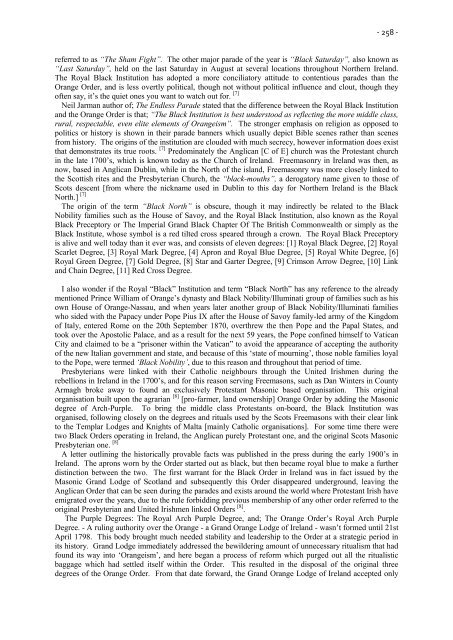TRAPPED IN A MASONIC WORLD
TRAPPED IN A MASONIC WORLD
TRAPPED IN A MASONIC WORLD
Create successful ePaper yourself
Turn your PDF publications into a flip-book with our unique Google optimized e-Paper software.
- 258 -<br />
referred to as ―The Sham Fight‖. The other major parade of the year is ―Black Saturday‖, also known as<br />
―Last Saturday‖, held on the last Saturday in August at several locations throughout Northern Ireland.<br />
The Royal Black Institution has adopted a more conciliatory attitude to contentious parades than the<br />
Orange Order, and is less overtly political, though not without political influence and clout, though they<br />
often say, it‘s the quiet ones you want to watch out for. [7]<br />
Neil Jarman author of; The Endless Parade stated that the difference between the Royal Black Institution<br />
and the Orange Order is that; ―The Black Institution is best understood as reflecting the more middle class,<br />
rural, respectable, even elite elements of Orangeism‖. The stronger emphasis on religion as opposed to<br />
politics or history is shown in their parade banners which usually depict Bible scenes rather than scenes<br />
from history. The origins of the institution are clouded with much secrecy, however information does exist<br />
that demonstrates its true roots. [7] Predominately the Anglican [C of E] church was the Protestant church<br />
in the late 1700‘s, which is known today as the Church of Ireland. Freemasonry in Ireland was then, as<br />
now, based in Anglican Dublin, while in the North of the island, Freemasonry was more closely linked to<br />
the Scottish rites and the Presbyterian Church, the ―black-mouths‖, a derogatory name given to those of<br />
Scots descent [from where the nickname used in Dublin to this day for Northern Ireland is the Black<br />
North.] [7]<br />
The origin of the term ―Black North‖ is obscure, though it may indirectly be related to the Black<br />
Nobility families such as the House of Savoy, and the Royal Black Institution, also known as the Royal<br />
Black Preceptory or The Imperial Grand Black Chapter Of The British Commonwealth or simply as the<br />
Black Institute, whose symbol is a red tilted cross speared through a crown. The Royal Black Preceptory<br />
is alive and well today than it ever was, and consists of eleven degrees: [1] Royal Black Degree, [2] Royal<br />
Scarlet Degree, [3] Royal Mark Degree, [4] Apron and Royal Blue Degree, [5] Royal White Degree, [6]<br />
Royal Green Degree, [7] Gold Degree, [8] Star and Garter Degree, [9] Crimson Arrow Degree, [10] Link<br />
and Chain Degree, [11] Red Cross Degree.<br />
I also wonder if the Royal ―Black‖ Institution and term ―Black North‖ has any reference to the already<br />
mentioned Prince William of Orange‘s dynasty and Black Nobility/Illuminati group of families such as his<br />
own House of Orange-Nassau, and when years later another group of Black Nobility/Illuminati families<br />
who sided with the Papacy under Pope Pius IX after the House of Savoy family-led army of the Kingdom<br />
of Italy, entered Rome on the 20th September 1870, overthrew the then Pope and the Papal States, and<br />
took over the Apostolic Palace, and as a result for the next 59 years, the Pope confined himself to Vatican<br />
City and claimed to be a ―prisoner within the Vatican‖ to avoid the appearance of accepting the authority<br />
of the new Italian government and state, and because of this ‗state of mourning‘, those noble families loyal<br />
to the Pope, were termed ‗Black Nobility‘, due to this reason and throughout that period of time.<br />
Presbyterians were linked with their Catholic neighbours through the United Irishmen during the<br />
rebellions in Ireland in the 1700‘s, and for this reason serving Freemasons, such as Dan Winters in County<br />
Armagh broke away to found an exclusively Protestant Masonic based organisation. This original<br />
organisation built upon the agrarian [8] [pro-farmer, land ownership] Orange Order by adding the Masonic<br />
degree of Arch-Purple. To bring the middle class Protestants on-board, the Black Institution was<br />
organised, following closely on the degrees and rituals used by the Scots Freemasons with their clear link<br />
to the Templar Lodges and Knights of Malta [mainly Catholic organisations]. For some time there were<br />
two Black Orders operating in Ireland, the Anglican purely Protestant one, and the original Scots Masonic<br />
Presbyterian one. [8]<br />
A letter outlining the historically provable facts was published in the press during the early 1900‘s in<br />
Ireland. The aprons worn by the Order started out as black, but then became royal blue to make a further<br />
distinction between the two. The first warrant for the Black Order in Ireland was in fact issued by the<br />
Masonic Grand Lodge of Scotland and subsequently this Order disappeared underground, leaving the<br />
Anglican Order that can be seen during the parades and exists around the world where Protestant Irish have<br />
emigrated over the years, due to the rule forbidding previous membership of any other order referred to the<br />
original Presbyterian and United Irishmen linked Orders [8] .<br />
The Purple Degrees: The Royal Arch Purple Degree, and; The Orange Order‘s Royal Arch Purple<br />
Degree. - A ruling authority over the Orange - a Grand Orange Lodge of Ireland - wasn‘t formed until 21st<br />
April 1798. This body brought much needed stability and leadership to the Order at a strategic period in<br />
its history. Grand Lodge immediately addressed the bewildering amount of unnecessary ritualism that had<br />
found its way into ‗Orangeism‘, and here began a process of reform which purged out all the ritualistic<br />
baggage which had settled itself within the Order. This resulted in the disposal of the original three<br />
degrees of the Orange Order. From that date forward, the Grand Orange Lodge of Ireland accepted only












![[Pham_Sherisse]_Frommer's_Southeast_Asia(Book4You)](https://img.yumpu.com/38206466/1/166x260/pham-sherisse-frommers-southeast-asiabook4you.jpg?quality=85)




